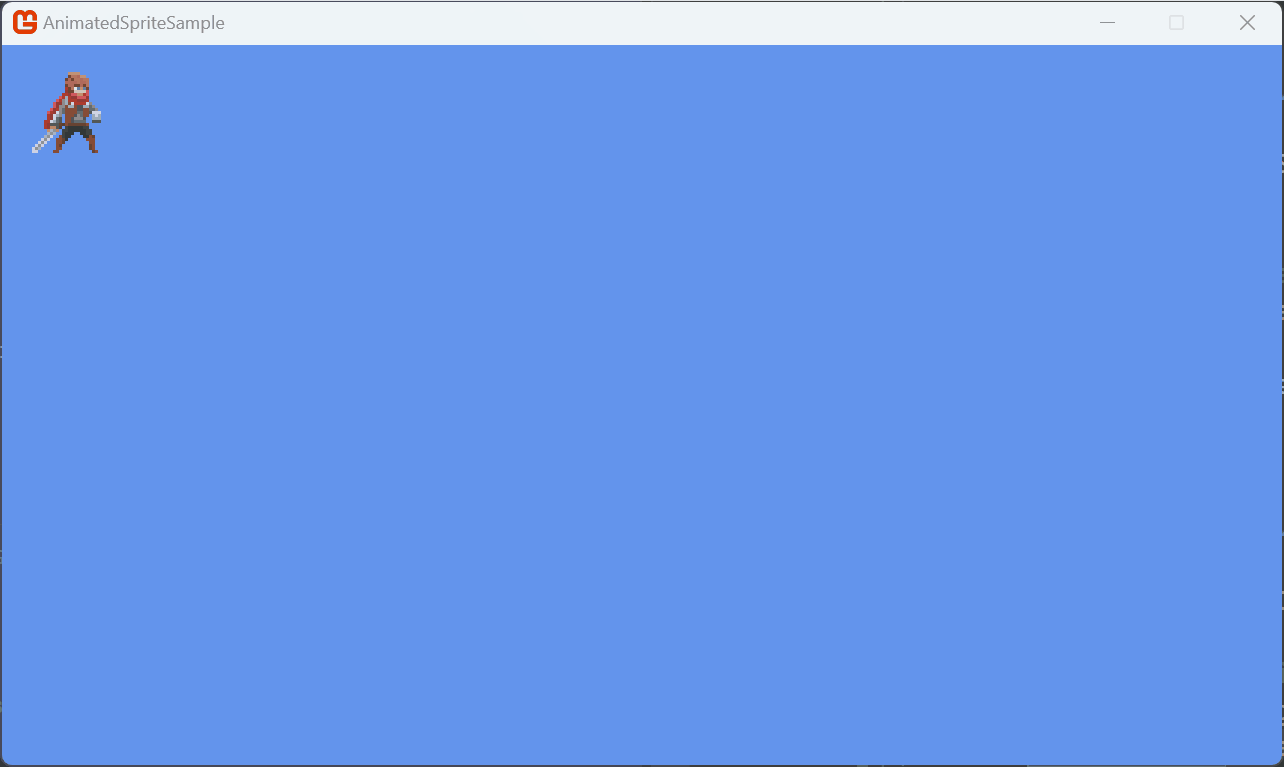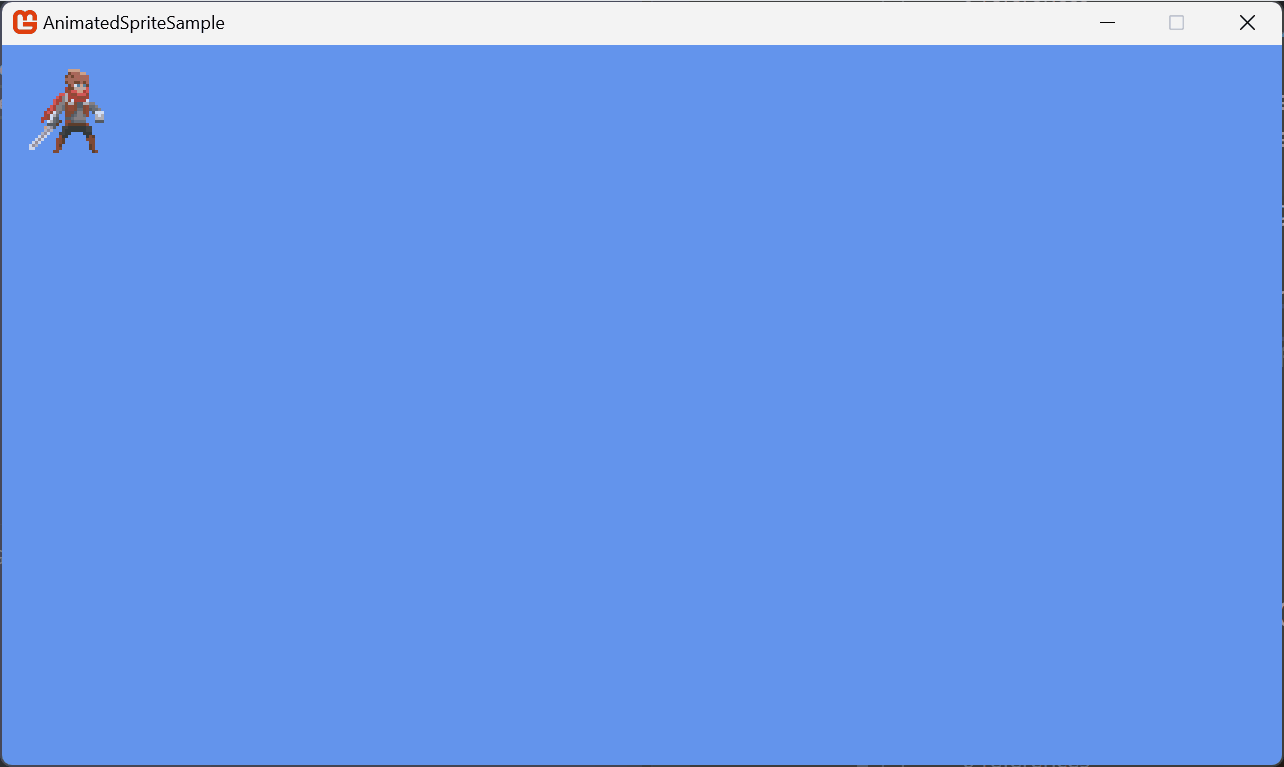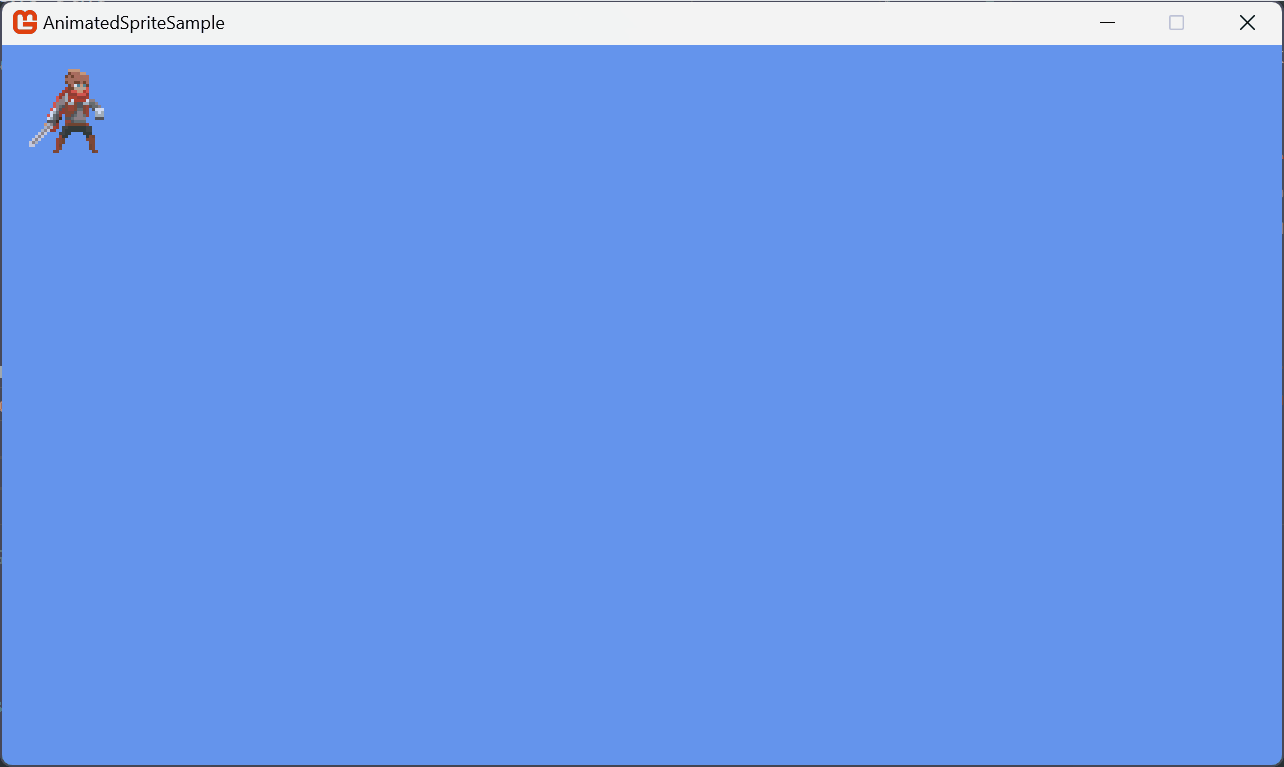AnimatedSprite
This page is up to date for MonoGame.Extended 5.3.1. If you find outdated information, please open an issue.
In the previous document about SpriteSheets we went over how to create a SpriteSheet, define animations, and retrieve the animations from it. Doing this only gives us the SpriteSheetAnimation instance for that animation, which we then have to create an AnimationController with to manage that single animation.
However, typically a SpriteSheet is going to contain several animations related to a single concept, like all of the animations for a player. To better manage controlling the animations from the SpriteSheet we can use the AnimatedSprite class.
Let's use the same example adventurer character from the SpriteSheet document.
Animated Pixel Adventurer by rvros; Licensed for free and commercial use.
Creating an AnimatedSprite
To create an AnimatedSprite first a SpriteSheet needs to be created with the animations defined. Building off of our previous example, it would look like this
protected override void LoadContent()
{
_spriteBatch = new SpriteBatch(GraphicsDevice);
Texture2DAtlas atlas = Content.Load<Texture2DAtlas>("adventurer");
SpriteSheet spriteSheet = new SpriteSheet("SpriteSheet/adventurer", atlas);
TimeSpan duration = TimeSpan.FromSeconds(0.1);
spriteSheet.DefineAnimation("attack", builder =>
{
builder.IsLooping(false)
.AddFrame("adventurer-attack3-00", duration)
.AddFrame("adventurer-attack3-01", duration)
.AddFrame("adventurer-attack3-02", duration)
.AddFrame("adventurer-attack3-03", duration)
.AddFrame("adventurer-attack3-04", duration)
.AddFrame("adventurer-attack3-05", duration);
});
spriteSheet.DefineAnimation("idle", builder =>
{
builder.IsLooping(true)
.AddFrame("adventurer-idle-2-00", duration)
.AddFrame("adventurer-idle-2-01", duration)
.AddFrame("adventurer-idle-2-02", duration)
.AddFrame("adventurer-idle-2-03", duration);
});
spriteSheet.DefineAnimation("run", builder =>
{
builder.IsLooping(true)
.AddFrame("adventurer-run-00", duration)
.AddFrame("adventurer-run-01", duration)
.AddFrame("adventurer-run-02", duration)
.AddFrame("adventurer-run-03", duration)
.AddFrame("adventurer-run-04", duration)
.AddFrame("adventurer-run-05", duration);
});
}
This creates the Texture2DAtlas based on a JSON data file that automatically generates the regions, creates a SpriteSheet using the atlas, then defines the animations for the attack, idle, and run animations. Note that the attack animation is set to false for looping. This will be important later.
Now that we have the SpriteSheet defined, let's use it to create an AnimatedSprite
private AnimatedSprite _adventurer;
protected override void LoadContent()
{
_spriteBatch = new SpriteBatch(GraphicsDevice);
Texture2DAtlas atlas = Content.Load<Texture2DAtlas>("adventurer");
SpriteSheet spriteSheet = new SpriteSheet("SpriteSheet/adventurer", atlas);
TimeSpan duration = TimeSpan.FromSeconds(0.1);
spriteSheet.DefineAnimation("attack", builder =>
{
builder.IsLooping(false)
.AddFrame("adventurer-attack3-00", duration)
.AddFrame("adventurer-attack3-01", duration)
.AddFrame("adventurer-attack3-02", duration)
.AddFrame("adventurer-attack3-03", duration)
.AddFrame("adventurer-attack3-04", duration)
.AddFrame("adventurer-attack3-05", duration);
});
spriteSheet.DefineAnimation("idle", builder =>
{
builder.IsLooping(true)
.AddFrame("adventurer-idle-2-00", duration)
.AddFrame("adventurer-idle-2-01", duration)
.AddFrame("adventurer-idle-2-02", duration)
.AddFrame("adventurer-idle-2-03", duration);
});
spriteSheet.DefineAnimation("run", builder =>
{
builder.IsLooping(true)
.AddFrame("adventurer-run-00", duration)
.AddFrame("adventurer-run-01", duration)
.AddFrame("adventurer-run-02", duration)
.AddFrame("adventurer-run-03", duration)
.AddFrame("adventurer-run-04", duration)
.AddFrame("adventurer-run-05", duration);
});
_adventurer = new AnimatedSprite(spriteSheet, "idle");
}
Updating the AnimatedSprite
The AnimatedSprite needs to be updated each frame so it can track the progress of the animation and change frames when the duration for the current frame has passed
protected override void Update(GameTime gameTime)
{
_adventurer.Update(gameTime);
}
Drawing the AnimatedSprite
The AnimatedSprite class is a child class of the Sprite class, so drawing it is done the same way, by just passing it to the SpriteBatch.Draw overload.
protected override void Draw(GameTime gameTime)
{
GraphicsDevice.Clear(Color.CornflowerBlue);
_spriteBatch.Begin(samplerState: SamplerState.PointClamp);
int scale = 3;
_spriteBatch.Draw(_adventurer, _adventurer.Origin * scale, 0, new Vector2(scale));
_spriteBatch.End();
base.Draw(gameTime);
}

The result of drawing the AnimatedSprite from the example code above.
Using Animation Event Triggers
Internally the AnimatedSprite uses the IAnimationController to control and manage the playback of the current animation. The IAnimationController interface provides an event that can be subscribed to that will trigger on various events.
For instance, in our example above, we set the attack animation to non looping. So let's update our code so that when we press the enter key, it performs the attack animation.
private KeyboardListener _keyboardListener;
protected override void Initialize()
{
_keyboardListener = new KeyboardListener();
_keyboardListener.KeyPressed += (sender, eventArgs) =>
{
if (eventArgs.Key == Keys.Enter && _adventurer.CurrentAnimation == "idle")
{
_adventurer.SetAnimation("attack");
}
};
}
protected override void Update(GameTime gameTime)
{
_keyboardListener.Update(gameTime);
_adventurer.Update(gameTime);
}
Now, if we run our sample and press the Enter key, the attack animation will play, but then when it ends, nothing happens. This is because we told it to be a non-looping animation when we defined it.

When we hit enter to set the attack animation, the attack animation plays, but since it's non-looping, it stops and does nothing after.
Instead, we would like to tell it that when the animation completes, it should go back to the idle animation. We can do this using the IAnimationController.OnAnimationEvent event.
Event Handler Management - Important Considerations
Before we implement animation events, there's an important concept to understand about event handlers in C#. Each time you subscribe to an event using a lambda expression or anonymous method, you're creating a new delegate instance. If you subscribe multiple times without unsubscribing, you'll accumulate handlers that all execute when the event fires.
This can lead to memory leaks and unexpected behavior where your code runs multiple times. For animation events, this means if a player pressed Enter multiple times, each press would add another handler, causing the idle animation to be set multiple times when any attack animation completes.
Let's look at the proper way to handle this:
protected override void Initialize()
{
_keyboardListener = new KeyboardListener();
_keyboardListener.KeyPressed += (sender, eventArgs) =>
{
if (eventArgs.Key == Keys.Enter && _adventurer.CurrentAnimation == "idle")
{
// Store a reference to our handler so we can unregister it later
void handler(IAnimationController animSender, AnimationEventTrigger trigger)
{
if (trigger == AnimationEventTrigger.AnimationCompleted)
{
// Important: Unregister the handler first to prevent accumulation
animSender.OnAnimationEvent -= handler;
_adventurer.SetAnimation("idle");
}
}
// Subscribe to the event with our handler
_adventurer.SetAnimation("attack").OnAnimationEvent += handler;
}
};
base.Initialize();
}
This approach creates a self-unregistering handler. The handler removes itself from the event after it executes, preventing accumulation of multiple handlers.
Always be mindful when subscribing to events inside loops, conditional blocks, or repeated operations. Lambda expressions create new delegate instances each time they're evaluated. For temporary event subscriptions like animation completion handlers, always unregister when done to prevent memory leaks and unexpected behavior.
If we run the sample now, when we press Enter, the attack animation will play. Once the animation completes, it will trigger the animation event, which we're now checking for and change it back to using the idle animation. Each press of Enter will work correctly without accumulating handlers.

The result of the code change to detect the animation completed event and switch from attack to idle animation from that.
Alternative Patterns for Complex Animation Management
For more complex scenarios with multiple animations and states, you might want to consider alternative patterns:
Persistent Event Handler Pattern
Instead of creating handlers for each animation, use a single persistent handler:
private bool _isAttacking;
protected override void Initialize()
{
// Set up a single persistent animation event handler
_adventurer.OnAnimationEvent += OnAnimationEvent;
_keyboardListener = new KeyboardListener();
_keyboardListener.KeyPressed += (sender, eventArgs) =>
{
if (eventArgs.Key == Keys.Enter && _adventurer.CurrentAnimation == "idle")
{
_isAttacking = true;
_adventurer.SetAnimation("attack");
}
};
base.Initialize();
}
private void OnAnimationEvent(object sender, AnimationEventTrigger trigger)
{
if (_isAttacking && trigger == AnimationEventTrigger.AnimationCompleted)
{
_isAttacking = false;
_adventurer.SetAnimation("idle");
}
}
protected override void UnloadContent()
{
// Clean up event handlers when disposing
if (_adventurer != null)
{
_adventurer.OnAnimationEvent -= OnAnimationEvent;
}
base.UnloadContent();
}
State Machine Pattern
For even more complex character behavior, consider implementing a state machine:
private enum CharacterState
{
Idle,
Attacking,
Running
}
private CharacterState _characterState = CharacterState.Idle;
protected override void Initialize()
{
_adventurer.OnAnimationEvent += OnAnimationEvent;
_keyboardListener = new KeyboardListener();
_keyboardListener.KeyPressed += (sender, eventArgs) =>
{
if (eventArgs.Key == Keys.Enter && _characterState == CharacterState.Idle)
{
_characterState = CharacterState.Attacking;
_adventurer.SetAnimation("attack");
}
};
base.Initialize();
}
private void OnAnimationEvent(object sender, AnimationEventTrigger trigger)
{
switch (_characterState)
{
case CharacterState.Attacking when trigger == AnimationEventTrigger.AnimationCompleted:
_characterState = CharacterState.Idle;
_adventurer.SetAnimation("idle");
break;
// Handle other state transitions...
}
}
Cleanup and Best Practices
Remember to clean up event handlers when your game objects are disposed to prevent memory leaks:
protected override void UnloadContent()
{
// Unsubscribe from events to prevent memory leaks
if (_adventurer != null)
{
// If using persistent handlers, unsubscribe them
_adventurer.OnAnimationEvent -= OnAnimationEvent;
}
base.UnloadContent();
}
Conclusion
The AnimatedSprite class provides a powerful way to manage multiple animations from a single SpriteSheet. By encapsulating the animation logic within the AnimatedSprite, it simplifies the process of updating, drawing, and controlling animations.
When working with animation events, always be mindful of event handler management to prevent memory leaks and unexpected behavior. The self-unregistering handler pattern shown in this tutorial works well for simple scenarios, while persistent handlers or state machines provide better structure for complex animation systems.
Using the IAnimationController interface and its event triggers thoughtfully, you can create robust animation systems that react to game events and user inputs while maintaining clean, maintainable code.